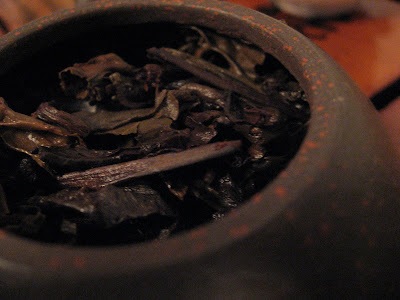
Aroma in the cup is not strong, but subdued, milky, and sharp. Taste begins with a smoke, followed by a lightly sweet vicosity, some milkiness, and a bit of wood. There is also a sour flavor which probably is responsible for all the sharp notes.

 I've actually tried this tea twice before. The first time, I had been drinking a lot of young sheng. Then, I thought it was a lucky find, having been wet-stored to get it more quickly to a stage where one can enjoy it more. The second time I tried it, I had been drinking mostly well-aged sheng. When I tried it the second time, I didn't like it much at all. The sour flavor starkly contrasted with the aged sheng I had been drinking, and left me feeling like this tea had been overly wet-stored.
I've actually tried this tea twice before. The first time, I had been drinking a lot of young sheng. Then, I thought it was a lucky find, having been wet-stored to get it more quickly to a stage where one can enjoy it more. The second time I tried it, I had been drinking mostly well-aged sheng. When I tried it the second time, I didn't like it much at all. The sour flavor starkly contrasted with the aged sheng I had been drinking, and left me feeling like this tea had been overly wet-stored.During todays tasting, I picked up on more flavors of the tea. I hadn't noticed the smoke or the milkiness before. I had noticed the viscosity, but didn't get a good grasp of it at the time. For this tasting, the tea took on a different character. My general thoughts are that it is too much on the side of a wet-stored tea. The sharp, sour flavor only becomes more and more pronounced as the session goes on, and one develops a strong aversion towards it. What also happens as the session goes on is that the tea becomes deep red-brown in color:

Unfortunately, I got sick of the snotty sour flavor and gave up on the tea early. Most probably, a good few years will get rid of a lot of that flavor, and that is probably what will happen with the few chunks left of the sample. It seems like it should be a good tea, but the snotty flavor is just too much. Perhaps a few more years will unlock some potential in it.

0 comments:
Post a Comment